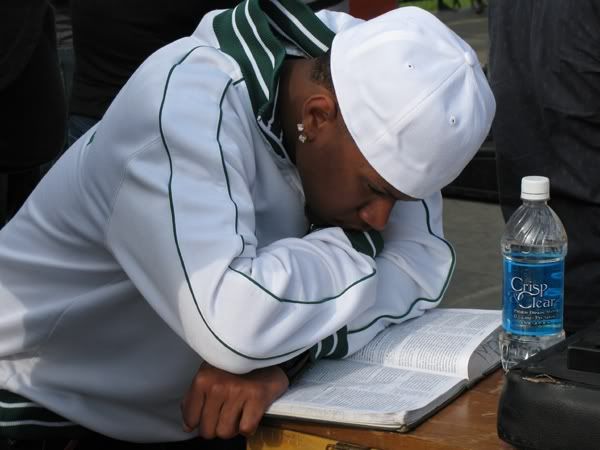 In this post we will once again delve into Lecrae’s “Don’t Waste Your Life,” this time stepping back and analyzing the overall structure of the video in an attempt to see his appeals to logos to set up pathos and ethos.
In this post we will once again delve into Lecrae’s “Don’t Waste Your Life,” this time stepping back and analyzing the overall structure of the video in an attempt to see his appeals to logos to set up pathos and ethos.Lecrae’s video uses mainly compare and contrast to make his argument. Since the subplot of the robbery of the store has not been explored, we will look more closely at this part of the video.
The storyline of the businessman (Cam) is highly polished and chronological. The robbery is not. The storyline of this subplot also jumps around, beginning first with the one of the robbers running, then cutting to them meeting outside. Lecrae also chooses to film the robbery in a grainy black and white, contrasting that with the clear color of Cam’s story. This contrast adds to the sense of universalism Lecrae is trying to get across. Instead of simply speaking to businessmen or gangsters, the contrasting storylines and filming styles show us that Lecrae believes lives in every culture are wasted.
Lecrae also uses the contrast of words and images to make his argument. While Cam is singing in the hook “Don’t wanna waste my/Don’t wanna waste my life,” two criminals are doing exactly that by robbing a store. As Lecrae is rapping “You don’t see His ways in the days of my life/You can hit my breaks/You can stop my life,” the video is showing Cam and a group of his friends at a party. In other words, the video shows the exact opposite of the words Lecrae is both rapping and writing. As Lecrae and Cam say they don’t want to waste their lives, Cam is doing so through partying and Lecrae is doing so through crime. Thus, the argument essentially made by telling the viewer “what not to do.”
This structure of logos also sets up the pathos and ethos in this song. The contrasting of the words and video sets up an ethos of equal footing. By choosing to portray the main characters themselves, Lecrae and Cam show the audience they are not saints on a level of perfection above their audience. Instead, they are men who were once wasting their lives in pursuit of the things of this world. Not coincidently, the stories portrayed in the video are loosely biographical of Lecrae and Cam. Lecrae grew up in the ghetto and was arrested several times. Cam, on the other hand, had been pursuing money and fame all his life.
The contrasting structure also appeals to pathos, by making the audience sympathetic toward the men wasting their lives. While logos is the main focus of the video, pathos is most certainly present.
Lecrae uses well-structured and contrasting to appeal to logos. He logically and passionately gives his message to all cultures in the world. He begs us to not waste our lives living for futile things, but instead live for Christ.
No comments:
Post a Comment